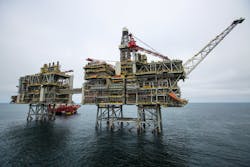Offshore Europe
Jeremy Beckman • London
BP strengthens grip on Clair
BP has agreed to an asset swap that would strengthen its interest in the Clair oilfield west of Shetland, the largest ongoing field development in UK waters. Subject to US and regulatory approvals, the company will sell to ConocoPhillips its entire interest in the Greater Kuparuk Area on Alaska’s North Slope, in exchange for an additional 16.5% stake in Clair. ConocoPhillips would retain a 7.5% share of the field.
The Clair Ridge project, north of the existing Phase One facilities which came onstream in 2005, should start up later this year. BP is targeting a further 640 MMboe recoverable from the current development, through two new bridge-linked platforms. Around 40 MMbbl could come from the application of the company’s in-house developed LoSal technique, which reduces the salinity of water injected into a reservoir to unblock the pores holding oil in certain clays, thereby improving recovery.
The new complex is designed to remain in service through 2050, and the company and its partners could take a final investment decision on a third development phase, the $300-million Clair South, in 2021. According to Luke Parker, an analyst with Wood Mackenzie, this phase could cost around $2.9 billion and start up in 2025, with production from Clair as a whole continuing to rise until 2027, with scope for upside through successful exploration drilling in the area. Parker added that ConocoPhillips’ shrunken share of the field would still be worth as much as all its other current UK offshore assets.
Another major, Chevron, is reportedly looking to sell all its interests in the UK central North Sea, which include the producing Alba and Britannia area field developments, although the company is looking to hold onto its stakes in Clair and the deepwater, but undeveloped, Rosebank oilfield west of Shetland. Swann estimated production from the package said to be on offer at around 65,000 boe/d.
Merger creates
pan-Norwegian player
Opportunities beckon in Norway too, with an increasing number of established players open to mergers or divestments. Eni and private equity investor HitecVision have agreed to combine Eni Norge with Point Resources into a new company named Vår Energi. This will have wide-ranging exploration and production interests throughout the Norwegian shelf, total resources of over 1,250 MMboe, and estimated production this year of around 180,000 boe/d from 17 active oil and gas fields. By 2023, output should reach 250,000 boe/d following planned investments of over $8 billion to develop more than 500 MMboe from 10 existing fields, at a breakeven of below $30/bbl. The new company, which will have over 800 employees, sees scope for further growth through exploration and additional transactions.
Eni Norge operates two producing fields, Goliat in the Barents Sea and Marulk in the Norwegian Sea, with interests in 55 licenses. Point Resources was only formed in 2016, following the merger of three Norwegian independents. Its main coup to date was acquiring ExxonMobil’s Norway business last year, including operatorship of the Balder and Ringhorne fields in the North Sea, where the company has been working on life extension measures.
Neptune Energy Group, which recently acquired GDF Suez’s North Sea area portfolio, has agreed to buy VNG’s Norwegian subsidiary which has total resources of over 50 MMboe. The deal would strengthen Neptune’s equity position in the greater Njord area of the Norwegian Sea, currently undergoing a major re-development. The company would also net VNG’s 30% operated stake in the Fenja project, a subsea tieback to Njord.
Troll set for further expansion
Equinor and its partners have committed to a third-phase development of the giant Troll field in the Norwegian Sea, as they look to extend production beyond 2050. Troll, which came onstream in 1995, currently supplies 8% of the European Union’s gas consumption.
The field, which features a large gas cap with an underlying thin oil zone, contains gas and oil in three slanted fault blocks. Phase 3, with an estimated cost of $965 million, will be a subsea solution directed at the gas cap at Troll West, involving two new subsea templates, eight producer wells, a 36-in. pipeline, and installation of a new processing module on the host Troll A platform. Aker Solutions is providing the subsea facilities – Equinor has awarded further contracts to Allseas, DeepOcean, and Nexans.
Assuming government approval for the amended development plan, production should begin in 2021, and the facilities should sustain plateau gas output from Troll over the following seven years.
Norway attracting drillers
Exploration is recovering offshore Norway despite the modest results from last year’s wells, particularly in frontier regions. The Norwegian Petroleum Directorate (NPD) expects up to 50 wells to be drilled across the shelf this year, up from 36 in 2016 and 2017. This follows growing interest in new exploration acreage in recent licensing rounds, which the NPD attributes to new insights based on better seismic; new exploration concepts arising from wells that have been successful; easier access to production infrastructure; and lower costs. But larger discoveries will be needed for production across the shelf to be sustained at high levels, NPD Exploration Director Torgeir Stordal warned, and those finds remain likeliest in areas that have been little explored. •


